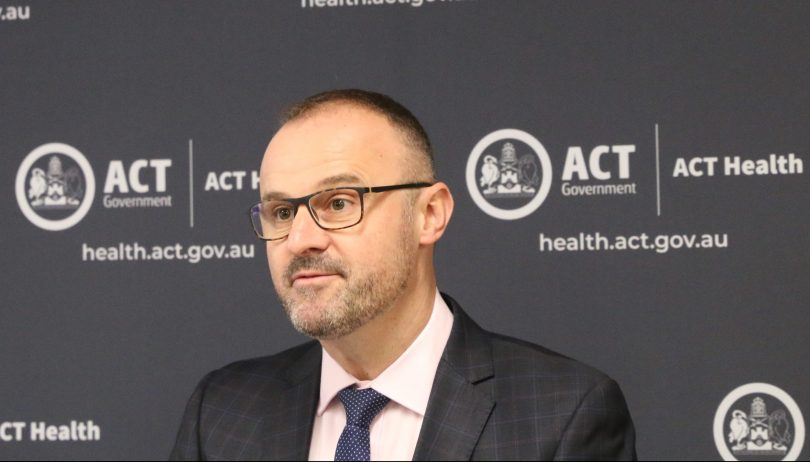
Chief Minister Andrew Barr says the current lockdown measures will be in place for at least the next month. Photo: Dominic Giannini.
Canberrans are set to endure at least another month in lockdown after a National Cabinet decision to maintain the current COVID-19 suppression measures.
Suppression of COVID-19 remains the primary focus of governments as Australia continues to flatten the curve and our health capacity is ramped up
Chief Minister Andrew Barr says the measures will be reviewed in two to three weeks, but no changes to the policy will be made until at least mid-May.
“We will continue to make these decisions based on expert health advice and through the policymaking framework of the National Cabinet,” he said.
“Consistency [will be sought] as much as possible within the Canberra region, so collaboration with the NSW Government will underpin our local public health response.”
Prime Minister Scott Morrison said restrictions would not be eased until a broader testing regime, better tracing ability and an increased local response capacity are in place.
Mr Morrison lauded state and territory health authorities for their work on testing and contact tracing – with modelling showing 92 per cent of symptomatic cases are being caught – but said Australia’s capacity had to improve before moving forward.
“We need the ability to move very fast and lockdown an outbreak where it occurs so it does not transmit more broadly,” he said.
Chief Medical Officer Dr Brendan Murphy reiterated this point, saying the federal medical advisory body is not confident enough to provide the government with a guarantee that our public healthcare system could handle an outbreak.
“We cannot afford to relax until we have a public health system which is so finely tuned that it can detect and respond to any outbreak,” he said.
“Our public health system is one of the best in the world, but we just have to hold the course while we get ourselves completely ready so that we can live through these next difficult months together.”
Mr Barr said the current lockdown measures are needed to buy our health system valuable time down the track.
“One of the things that we are doing successfully at the moment through our suppression of the virus is buying time for more equipment to be manufactured locally, within Australia, but also to be imported from offshore.
“This boost in the supply of personal protective equipment (PPE) will be essential to undertake more activities in the health system and respond to the pandemic in future stages.
“It is so important that we continue our collective efforts as a community to slow the spread of the virus in order to buy our health system time to acquire that equipment – to have it produced and to have it available for our health professionals.”
The lifting of measures may also be based on the willingness of Canberrans to sign up to a tracking app that will allow the government – with permission – to trace their movements.
“We really do need to have a discussion about the nature of [contact tracing] technology and people’s willingness to voluntarily utilise it,” Mr Barr said.
“In Singapore, where the technology is currently being utilised, it has a take-up rate of 20 per cent. The advice we have is that you would need at least 40 per cent to utilise it to make it worthwhile.
“It is a question for Australians, would they be prepared to sign up to such a technology? Time will tell.”
















